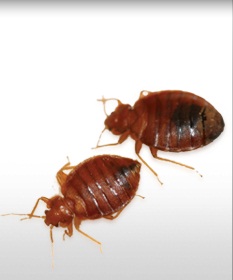Bed Bugs
Parts of this information was taken from the http://en.wikipedia.org/wiki/Bed_bug
 Bed bugs are small wingless insects that feed exclusively on the blood of warm blooded-animals. As we are warm-blooded animals we are ideal hosts for them. Bed bugs are small wingless insects that feed exclusively on the blood of warm blooded-animals. As we are warm-blooded animals we are ideal hosts for them.
They inhabit the nests of birds and the roosts of bats. Some of them have learnt to adapt to the human environment and live in our beds. Newborns, called hatchlings or nymphs, are tiny, about the size of a poppy seed, while adults grow to about ¼ of an inch long. Their shape is oval and flattened. Both nymphs, eggs and adults are visible to the naked eye.
They are called bed bugs because of their preferred habitat in human homes: sofas, bed mattresses and other soft furnishings.
When seen close up they may have a white, light tan to a deep brown or burnt orange color. Just after molting most of them are plain white. When they have had their feed a dark red or black blob may be observed within their body. They will instinctively seek shelter in dark cracks and crevices when disturbed.
The bug is attracted to the host by both its warmth and the presence of C02 (carbon dioxide). They will reach their host either by crawling straight towards them, or climbing a wall and then across the ceiling until they feel a heat wave - when they jump down onto their host.
Do bed bugs transmit disease?
Although they look very much like the kind of insect that would transmit disease, like mosquitoes, there are no records anywhere of disease transmission caused by bed bugs - even from sick host to healthy host.
A study carried out by scientists at the Department of Medicine, University of Mississippi Medical Center, Jackson, USA, that reviewed the available evidence on bed bugs found that while they are highly resistant to various ways of getting rid of them, they seem to be more of a nuisance than a serious health problem, but the possibility that they could one day serve as a vehicle for disease has not been well researched.
Scientists say there may be as many as 40 pathogens that could potentially live inside a bed bug or around its mouth area. However, tests have concluded that bed bugs are highly unlikely to carry disease from host to host.
Researchers have concluded that they are much less hazardous to human health than fleas, or other common insects. Nevertheless, these are well formulated opinions, rather than the results of conclusive studies. Some say hepatitis B or Chagas disease could not be discarded as possibilities if the setting were right.
Controlling infestations of bed bugs
Since they can hide in so many places, they are not easy to eradicate. Unless you have a lot of time at your disposal, and limitless patience, it is advisable to get a professional in pest control. Experts know where to look for them, as well as how to get rid of them.
You can help the pest control professional by removing excess clutter from your house. If your stuff is strewn about rooms the bed bugs will have many extra places to hide, making inspection and eradication that much more difficult.
|